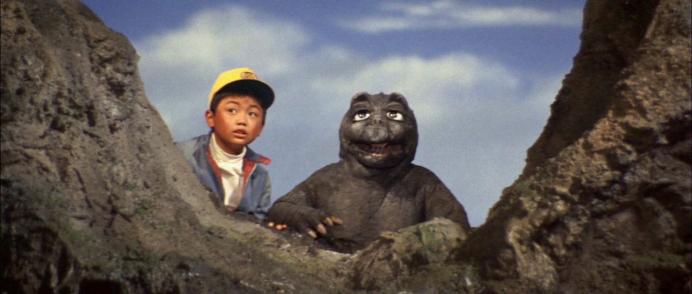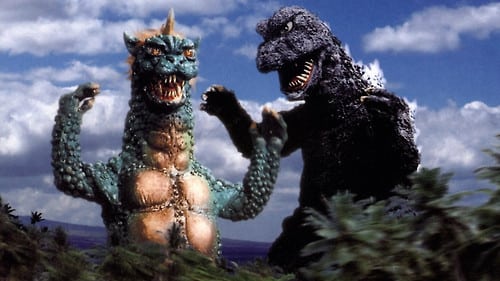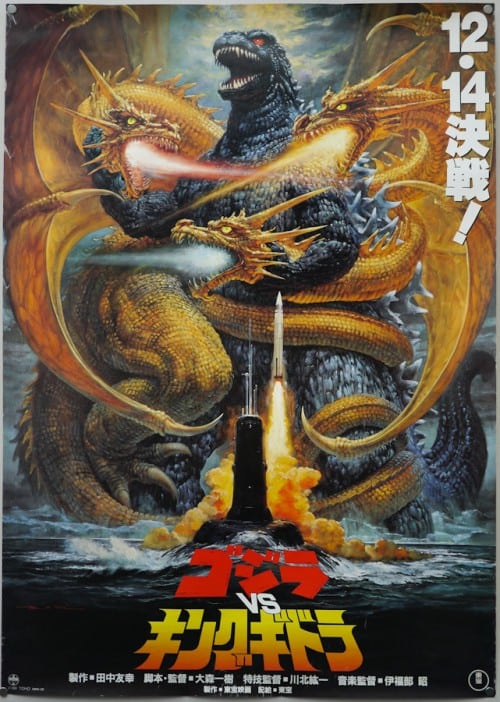All Monsters Attack (1969)
Directed by: Ishirô Honda
Written by: Shinichi Sekizawa
Starring: Eisei Amamoto, Kanji Sahara, Machiko Naka, Tomonori Yazaki
HCF REWIND NO.137. ALL MONSTERS ATTACK AKA GOJIRA MINILLA GABARA: ORU KAIJI DAISHINGEKI, GODZILLA’S REVENGE [Japan 1969]
AVAILABLE ON DVD
RUNNING TIME: 70 min
FEATURED MONSTERS: GODZILLA, MINILLA, GABARA, KAMIKARAS, EBIRAH, GOROSAURUS, MANDA
REVIEWED BY: Dr Lenera, Official HCF Critic
Ichiro Miki is a highly imaginative but lonely kid growing up in urban, polluted Tokyo, whose mother and father constantly work late. His only friends are toymaker Shinpei Inami and girl Sachiko. Every day after school, Ichiro is tormented by a gang of bullies led by a child named Sancho, whom Ichiro has nicknamed ‘Gabara’. When he is asleep, Ichiro starts to dream about visiting Monster Island. He witnesses Godzilla battling three Kamacuras and Ebirah, and is rescued from a cave by Godzilla’s son Minilla. Minilla has bully problems too, continually pestered by a monstrous ogre…..called Gabara…..
We’re in the year 1969 now, so it’ll be of no surprise that we now come to the two oddest entries in the Godzilla series. More commonly known as the even more misleading Godzilla’s Revenge, All Monsters Attack is hated by many fans and stands apart from all the other films in the series in that all the monster footage exists in the mind of a small boy. The sad thing is that much of the monster stuff is from earlier films, but if you ignore that [which is hard], and certain problems that come with it like the Godzilla suit changing several times, it’s quite an interesting little film, and, while clearly aimed straight at small boys who would see the character of Ichiro as just like them, it’s actually a more complex and intelligent picture than it initially may seem. In teaching life lessons to children and mildly preaching to both children and parents alike, it’s directed by Ishiro Honda with great conviction, the filmmaker obviously relishing the chance to make a film that wasn’t just about giant monsters on the loose, something that had not been the case for a while. It’s certainly not a classic Godzilla film, with several aspects that don’t quite work, but it’s very interesting.
Destroy All Monsters had not been the hit that Toho expected, but producer Tomoyuki Tanaka still wanted to continue the series, so they let Honda and writer Shinichi Sekizawa craft another one, but only gave them a very small budget to work with [this was partially because of what had happened with the production of Latitude Zero, see review of that film for details]. They tried to use the lack of money to their advantage, though Tanaka was probably leaning on them to emulate the Daiei studio’s Gamera [the giant flying turtle] movies, which usually had a small boy make friends with the monster. Though Eiji Tsuburaya was credited with the special effects out of respect, he didn’t actually work on the film at all. Honda did the effects [well, the ones that weren’t stock footage] himself, which would have certainly saved some money. Despite its uniqueness, it was another commercial failure and convinced Honda to give up on directing Godzilla films. In the US, it saw a tiny release as Minya, Son Of Godzilla, until, under the distribution of Henry P. Saperstein’s Maron Films, it was pulled and then re-released, actually uncut though with a different title theme, as Godzilla’s Revenge, double-billed with both Island Of The Burning Damned and War Of The Gargantuas. They miss-marketed it a typical monster movie aimed at adults, which may go some way to explaining why it didn’t please many fans.
After a title sequence which not only shows shots from later in the movie but clips from Mothra Vs Godzilla and Destroy All Monsters [providing us with the only shots of destruction in the film], the scene is set with shots of the smoggy Tokyo of 1969, and a really interesting feature of this movie is the way it depicts the city, which is very different from previous films. This Tokyo is a man-made industrial wasteland, full of decay and pollution, and, while more would be done with all this in the next Godzilla film, there is no doubt that this is something of a hell hole and it is entirely understandable that a child would want to escape to a lush tropical paradise like Monster Island [though chronologically this doesn’t much sense, because Destroy All Monsters had been set in the future, unless Ichiro had just watched that film and therefore created his dream monster encounters from it?]. This poor child also has a mother and father who are hardly ever home because they have to work, Japan being in the midst of an economic crisis at the time [they should re-release the film in the UK right now], and, because he is bullied, his only friends are a girl and an inventor. There’s a poignant scene where Inami gives him what, judging by the look of sheer pleasure on Ichiro’s face, could be his first decent meal in days.
So no wonder he wants to get away, and the film has three long sections on Monster Island. Scenes from Godzilla Vs The Sea Monster and Son Of Godzilla are repeated as Ichiro sees Godzilla fight Ebirah, the Kamikuras and some planes, and there are brief shots from King Kong Escapes and Destroy All Monsters here too. The scenes where Ichiro and Minilla make friends are cute. Minilla talking is ‘too much’ for some, but it’s notable that Godzilla is an even meaner parent than before here, constantly making Minilla face the creature Gabara who is bullying him here. The scene where Godzilla tries to teach Minilla to use his radioactive breath from Son Of Godzilla is, intriguingly, not re-used, but re-shot to make Godzilla seem tougher. The Godzilla suit is the same one from Destroy All Monsters. Sadly, none of the new Honda-shot effects footage is very exciting. Even when Godzilla finally decides to go up against Gabara, the fight is brief and quite feeble. Gabara, something of a reptilian version of King Kong though with a cat-like face, is unimpressive. Honda was obviously more interested in the ‘real’ scenes, though even they also sometimes miss the mark. The story gradually brings in a pair of crooks who we know will cross paths with Ichiro. Like most Honda villains, they are incompetent, but this pair are so stupid, constantly doing things like falling over and bumping heads, we don’t feel much danger from them, even when they chase Ichiro around a warehouse in a sequence which has more than a touch of the much later Home Alone about it.
This film really is ‘about’ stuff though, and its honesty takes it through most of the weak bits. Ichiro eventually stands up to the kid bullying him, and, while some have said he may now become a bully himself, I think they’re wrong: just look at the scene at the end where he causes a painter to be covered in paint, and then visibly regrets it. Rather, the film seems to be saying that to survive, you may sometimes need to commit acts which you may afterwards regret, and also that it’s a fine line between being a hero and being a bully. This isn’t really a happy film at all. Ichiro’s mother may say that she’ll spend more time with her son, but is then seen to cry as she obviously worries how she’ll put money on the table. Honda and Sekizawa may be, in a sense, preaching to kids and parents, but are also astute enough to realise and brave enough to tell us that the problems will not just go away. Then there’s a really cool scene [remember, this is 1969] where Inami demonstrates his new invention, an integrated monitor and keyboard desktop computer which, on Ichiro’s recommendation, is re-tooled so it will play not just one, but a variety of games! Fancy that. As usual, in Godzilla-land, they are way ahead of the times.
Honda reinforces the themes of his film visually throughout like rarely having Ichiro and his parents in the same shot, gives us a surprising number of hand-held shots, and presents the odd scene very strangely, like the final tussle with the bully shown by still and blurred images. Overall, he really seems invested in this film. Tomonori Yazaki, playing Ichiro, is quite good as registering things like fear and wonder, though sometimes appears rather too happy. Eisei Amamoto, usually playing villains, is charismatic as Inami. Akira Ifukube would probably have been wrong to score All Monsters Attack, so they gave the job to Kunio Miyauchi, whose music, scored for a jazz combo, is appropriately lighter in tone than Ifukube’s, and even cartoon-like. He provides a rather groovy [if overly repeated] main theme and some charming music for Ichiro and Minilla. Interestingly, this is one area in which the American version improved on the Japanese one. The Japanese version features a vocal version of the main theme over the opening credits where a boy unpleasantly screams the words. The US one substitutes this annoying track with a very good jazz instrumental called Crime Fiction, composed by Ervin Jereb. Sometimes childlike, yet sometimes very mature, All Monsters Attack has its problems but is a fascinating film and a one-of-a-kind Godzilla film that should be proof to anyone of the diversity of a series many probably think is all the same. And it’s probably the best film with which to introduce your child to Godzilla!
Rating: 

















Be the first to comment